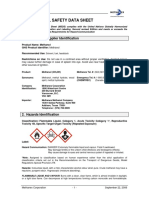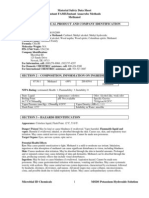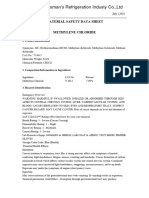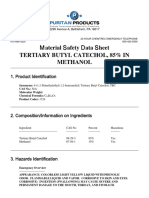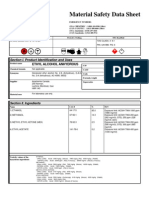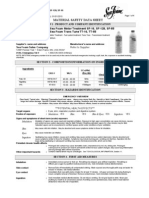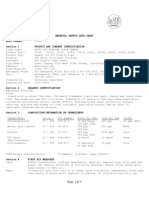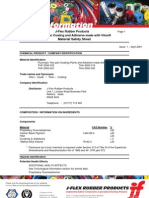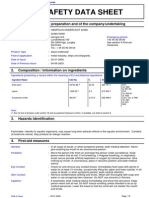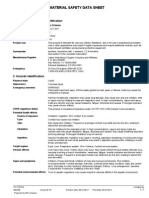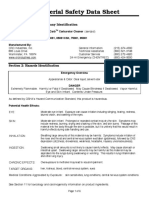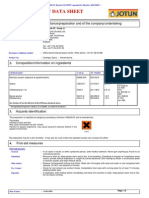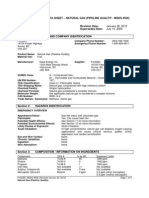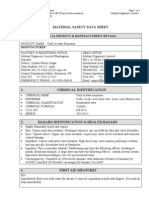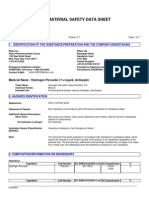Methanol (Ch3oh) Msds
Methanol (Ch3oh) Msds
Uploaded by
sahilchemCopyright:
Available Formats
Methanol (Ch3oh) Msds
Methanol (Ch3oh) Msds
Uploaded by
sahilchemCopyright
Available Formats
Share this document
Did you find this document useful?
Is this content inappropriate?
Copyright:
Available Formats
Methanol (Ch3oh) Msds
Methanol (Ch3oh) Msds
Uploaded by
sahilchemCopyright:
Available Formats
Methanol
MATERIAL SAFETY DATA SHEET
This Material Safety Data Sheet complies with the Canadian Controlled Product Regulations and the United States Occupational Safety and Health Administration (OSHA) hazard communication standard.
1. Product and Supplier Identification
Product: Synonyms: Methanol (CH3OH) Methyl alcohol, methyl hydrate, wood spirit, methyl hydroxide Solvent, fuel, feedstock Methanex Corporation, 1800 Waterfront Centre, 200 Burrard Street, Vancouver, B.C. V6C 3M1 Note: CHEMTREC number to be used only in the event of chemical emergencies involving a spill, leak, fire, exposure or accident involving chemicals. Non-Emergency Tel. #: Emergency Tel. #: (CHEMTREC) (604) 661-2600 1-800-424-9300 (Canada and US)
Product Use: Company Identification:
2. Composition
Component Methanol (CAS 67-56-1) % (w/w) 99-100 Exposure Limits* ACGIH TLV-TWA: 200 ppm, skin STEL: 250 ppm, skin notation OSHA PEL: 200 ppm TLV Basis, critical effects: neuropathy, vision, central nervous system LD50
5628 mg/kg (oral/rat) 20 ml/kg (dermal/ rabbit)
LC50
64000 ppm (inhalation/rat)
* Exposure limits may vary from time to time and from one jurisdiction to another. Check with local regulatory agency for the exposure limits in your area.
3. Hazards Identification
Routes of Entry: Skin Contact: Moderate Eye Contact: Moderate Ingestion: Major Effects of Short-Term (Acute) Exposure: Inhalation: Inhalation of high airborne concentrations can also irriate mucous membranes, cause headaches, sleepiness, nausea, confusion, loss of consciousness, digestive and visual disturbances and even death. NOTE: Odour threshhold of methanol is several times higher than the TLV-TWA. Depending upon severity of poisoning and the promptness of treatment, survivors Inhalation: Major
Methanex Corporation
-1-
October 13, 2005
Methanol
may recover completely or may have permanent blindness, vision disturbances and/or nervous system effects. Concentrations in air exceeding 1000 ppm may cause irritation of the mucous membranes. Skin Contact: Methanol is moderately irritating to the skin. Methanol can be absorbed through the skin and harmful effects have been reported by this route of entry. Effects are similar to those described in Inhalation Eye Contact: Methanol is a mild to moderate eye irritant. High vapour concentration or liquid contact with eyes causes irritation, tearing and burning. Ingestion: Swallowing even small amounts of methanol could potentially cause blindness or death. Effects of sub lethal doses may be nausea, headache, abdominal pain, vomiting and visual disturbances ranging from blurred vision to light sensitivity. Effects of Long-Term (Chronic) Exposure: Repeated exposure by inhalation or absorption may cause systemic poisoning, brain disorders, impaired vision and blindness. Inhalation may worsen conditions such as emphysema or bronchitis. Repeated skin contact may cause dermal irritation, dryness and cracking. Medical Conditions Aggravated By Exposure: Emphysema or bronchitis.
4. First Aid Measures
Note: Emergency assistance may also be available from the local poison control centre. Eye Contact: Remove contact lenses if worn. In case of contact, immediately flush eyes with plenty of clean running water for at least 15 minutes, lifting the upper and lower eyelids occasionally. Obtain medical attention. Skin Contact: In case of contact, remove contaminated clothing. In a shower, wash affected areas with soap and water for at least 15 minutes. Seek medical attention if irritation occurs or persists. Wash clothing before reuse. Inhalation: Remove to fresh air, restore or assist breathing if necessary. Obtain medical attention. Ingestion: Swallowing methanol is potentially life threatening. Onset of symptoms may be delayed for 18 to 24 hours after digestion. If conscious and medical aid is not immediately available, do not induce vomiting. In actual or suspected cases of ingestion, transport to medical facility immediately. NOTE TO PHYSICIAN: Acute exposure to methanol, either through ingestion or breathing high airborne concentrations can result in symptoms appearing between 40 minutes and 72 hours after exposure. Symptoms and signs are usually limited to CNS, eyes and gastrointestinal tract. Because of the initial CNSs effects of headache, vertigo, lethargy and confusion, there may be an impression of ethanol intoxication. Blurred vision, decreased acuity and photophobia are common complaints. Treatment with ipecac or lavage is indicated in any patient presenting within two hours of ingestion. A profound metabolic acidosis occurs in severe poisoning and serum bicarbonate levels are a more accurate measure of severity than serum methanol levels. Treatment protocols are available from most major hospitals and early collaboration with appropriate hospitals is recommended.
Methanex Corporation
-2-
October 13, 2005
Methanol
5. Fire Fighting Measures
Flash point: Autoignition temperature: Lower Explosive Limit: Upper Explosion Limit: Sensitivity to Impact: Sensitivity to Static Discharge: Hazardous Combustion Products: 11oC (TCC) 385 oC (NFPA 1978), 470 oC (Kirk-Othmer 1981; Ullmann 1975) 6% (NFPA, 1978) 36% (NFPA, 1978), 36.5% (Ullmann, 1975) Low Low
Toxic gases and vapours; oxides of carbon and formaldehyde. Extinguishing Media: Small fires: Dry chemical, CO2, water spray Large fires: Water spray, AFFF(R) (Aqueous Film Forming Foam (alcohol resistant)) type with either a 3% or 6% foam proportioning system. Fire Fighting Instructions: Methanol burns with a clean clear flame that is almost invisible in daylight. Stay upwind! Isolate and restrict area access. Concentrations of greater that 25% methanol in water can be ignited. Use fine water spray or fog to control fire spread and cool adjacent structures or containers. Contain fire control water for later disposal. Fire fighters must wear full face, positive pressure, self-contained breathing apparatus or airline and appropriate protective clothing. Protective fire fighting structural clothing is not effective protection from methanol. Do not walk through spilled product. NATIONAL FIRE PROTECTION ASSOCIATION (NFPA) HAZARD INDEX: HEALTH: 1 FLAMMABILITY: 3 REACTIVITY: 0
6. Accidental Release Measures
Overview: Flammable liquid which can burn without a visible flame. Release can cause an immediate risk of fire and explosion. Eliminate all ignition sources, stop leak and use absorbent materials. If necessary, contain spill by diking. Fluorocarbon alcohol resistant foams may be applied to spill to diminish vapour and fire hazard. Maximize methanol recovery for recycling or re-use. Restrict access to area until completion of cleanup. Ensure cleanup is conducted by trained personnel only. Wear adequate personal protection and remove all sources of ignition. Notify all governmental agencies as required by law. Personal Protection: Full face, positive pressure self-contained breathing apparatus or airline, and protective clothing must be worn. Protective fire fighting structural clothing is not effective protection from methanol. Environmental Precautions: Biodegrades easily in water Methanol in fresh or salt water may have serious effects on aquatic life. A study on methanols toxic efffects on sewage sludge bacteria reported little effect on digestion at 0.1% while 0.5% methanol retarded digestion. Methanol will be broken down to carbon dioxide and water. Remedial Measures: Flammable liquid. Release can cause an immediate fire/explosion hazard. Eliminate all sources of ignition, stop leak and use absorbent materials. Collect liquid with explosion proof pumps. Do not walk through spill product as it may be on fire and not visible.
Methanex Corporation
-3-
October 13, 2005
Methanol
Large Spills: If necessary, contain spill by diking. Fluorocarbon alcohol resistant foams may be applied to spill to diminish vapour and fire hazard. Maximize methanol recovery for recycling or reuse. Collect liquid with explosion proof pumps. Small Spills: Soak up spill with non-combustible absorbent material. Recover methanol and dilute with water to reduce fire hazard. Prevent spilled methanol from entering sewers, confined spaces, drains, or waterways. Restict access to unprotected personnel. Put material in suitable, covered, labeled containers. Flush area with water.
7. Handling and Storage
Handling Procedures: No smoking or open flame in storage, use or handling areas. Use explosion proof electrical equipment. Ensure proper electrical grouding procedures are in place. Storage: Store in totally enclosed equipment, designed to avoid ignition and human contact. Tanks must be grounded, vented, and should have vapour emission controls. Tanks must be diked. Avoid storage with incompatible materials. Anhydrous methanol is non-corrosive to most metals at ambient temperatures except for lead, nickel, monel, cast iron and high silicon iron. Coatings of copper (or copper alloys), zinc (including galvanized steel), or aluminum are unsuitable for storage. These materials may be attacked slowly by the methanol. Storage tanks of welded construction are normally satisfactory. They should be designed and built in conformance with good engineering practice for the material being stored. While plastics can be used for short term storage, they are generally not recommended for long-term storage due to deterioration effects and the subsequent risk of contamination. Corrosion rates for several construction materials: <0.508 mm/year <0.051 mm/year Some attack Satisfactory Resistant Cast iron, monel, lead, nickel High silicon iron Polyethylene Neoprene, phenolic resins, polyesters, natural rubber, butyl rubber Polyvinyl chloride, unplasticized
8. Exposure Controls, Personal Protection
Engineering Controls: In confined areas, local and general ventilation should be provided to maintain airborne concentrations below permissible exposure limits. Ventilation systems must be designed according to approved engineering standards. Respiratory Protection: NIOSH approved supplied air respirator when airborne concentrations exceed exposure limits. Skin protection: Butyl and nitrile rubbers are recommended for gloves. Check with manufacturer. Wear chemical resistant pants and jackets, preferably of butyl or nitrile rubber. Check with manufacturer. Eye and Face Protection: Face shield and chemical splash goggles when transferring is taking place. Footwear: Chemical resistant, and as specified by the workplace. Other: Eyewash and showers should be located near work areas. NOTE: PPE must not be considered a long-term solution to exposure control. PPE usage must be accompanied by employer programs to properly select, maintain, clean, fit and use. Consult a competent industrial
Methanex Corporation
-4-
October 13, 2005
Methanol
hygiene resource to determine hazard potential and/or the PPE manufacturers to ensure adequate protection.
9. Physical and Chemical Properties
Appearance: Liquid, clear, colourless Odour: Mild characteristic alcohol odour
Odour Threshold: detection: 4.2 - 5960 ppm (geometric mean) 160 ppm recognition: 53 8940 ppm (geometric mean) 690 ppm
Boiling Point: 64.7 oC @ 101.3 kPa Critical Temperature: 239.4 oC Relative Density: 0.791 Evaporation Rate: 4.1 (n-butyl acetate =1) Partition Coefficient: Log P (oct) = -0.82 Solubility in other Liquids: Soluble in all proportions in other alcohols, esters, ketones, ethers and most other organic solvents
pH: Not applicable Vapour Pressure: 12.8 kPa @ 20oC Solubility: Completely soluble Vapour Density: 1.105 @ 15 oC Freezing Point: -97.8 oC
10.
Chemical Stability: Incompatibility: Yes
Stability and Reactivity
Yes. Avoid contact with strong oxidizers, strong mineral or organic acids, and strong bases. Contact with these materials may cause a violent or explosive reaction. May be corrosive to lead, aluminum, magnesium, and platinum.
Conditions of Reactivity: Presence of incompatible materials and ignition sources. Hazardous Decomposition Products: Formaldehyde, carbon dioxide, and carbon monoxide. Hazardous Polymerization: Will not occur.
11.
LD50: LC50: Acute Exposure: Chronic Exposure: Exposure Limits: Irritancy: Sensitization: Carcinogenicity: Teratogenicity: Reproductive toxicity: Mutagenicity: Synergistic products:
Toxicological Information
5628 mg/kg (oral/rat), 20 ml/kg (dermal/rabbit) 64000 ppm (rat) See Section 3 See Section 3. See Section 2. See Section 3. No Not listed by IARC, NTP, ACGIH, or OSHA as a carcinogen. No Reported to cause birth defects in rats exposed to 20,000 ppm Insufficient data None Known
Methanex Corporation
-5-
October 13, 2005
Methanol
12.
Ecological Information
Environmental toxicity: Methanol in fresh or salt water may have serious effects on aquatic life. A study on methanols toxic effects on sewage sludge bacteria reported little effect on digestion at 0.1% while 0.5% methanol retarded digestion. Methanol will be broken down into carbon dioxide and water. Biodegradability: Biodegrades easily in water.
13.
Disposal Considerations
Review federal, provincial or state, and local government requirements prior to disposal. Store material for disposal as indicated in Section #7, Handling and Storage. Disposal by controlled incineration or by secure land fill may be acceptable.
14.
Transport Information
Methanol, Class 3(6.1), UN1230, P.G. II Limited Quantity: 1 litres Methanol, Class 3, UN 1230, P.G. II, (RQ 5000 lbs/2270 kg) Limited Quantity: 1 litres Methanol, Class 3(6.1), UN1230, P.G. II Packaging Instruction: 305, 1 litre maximum per package, Methanol, Class 3(6.1), UN1230, P.G. II, Flash Point = 12 oC EmS No. F-E, S-D Stowage Category B, Clear of living quarters
Transport of Dangerous Goods (TDG and CLR):
United States Department of Transport (49CFR): (Domestic Only)
International Air Transport Association (IATA):
International Maritime Organization (IMO):
15.
Regulatory Information
CANADIAN FEDERAL REGULATIONS: CEPA, DOMESTIC SUBSTANCES LIST: Listed WHMIS CLASSIFICATION: UNITED STATES REGULATIONS: 29CFR 1910.1200 (OSHA): 40CFR 116-117 (EPA): 40CFR 355, Appendices A and B: 40CFR 372 (SARA Title III): 40CFR 302 (CERCLA): Hazardous Hazardous Subject to Emergency Planning and Notification Listed Listed B2, D1A
Methanex Corporation
-6-
October 13, 2005
Methanol
16. Other Information
Preparation Date: October 13, 2005 Prepared by: Kel-Ex Agencies Ltd., P.O. Box 52201, Lynnmour RPO, North Vancouver, B.C., V7J 3V5 Disclaimer: The information above is believed to be accurate and represents the best information currently available to us. Users should make their own investigations to determine the suitability of the information for their particular purposes. This document is intended as a guide to the appropriate precautionary handling of the material by a properly trained person using this product. Methanex Corporation and its subsidiaries make no representations or warranties, either express or implied, including without limitation any warranties of merchantability, fitness for a particular purpose with respect to the information set forth herein or the product to which the information refers. Accordingly, Methanex Corp. will not be responsible for damages resulting from use of or reliance upon this information. Revisions: None
Methanex Corporation
-7-
October 13, 2005
You might also like
- History of MathematiciansDocument15 pagesHistory of MathematiciansAnkesh Kumar Yadav67% (3)
- Methylated SpiritDocument7 pagesMethylated SpiritPiNo ratings yet
- Komatsu Diesel Engine Oil EO 15W-40 LA: Safety Data SheetDocument7 pagesKomatsu Diesel Engine Oil EO 15W-40 LA: Safety Data SheetPierre LunaNo ratings yet
- MSDS Mita Emery Oil 6007509Document7 pagesMSDS Mita Emery Oil 6007509jesuscasasNo ratings yet
- Msds Ldpe en UsDocument3 pagesMsds Ldpe en UssahilchemNo ratings yet
- MGSC 491 Syllabus Fall 2016Document8 pagesMGSC 491 Syllabus Fall 2016Terrence Yao100% (1)
- Methanol (Ch3oh) MsdsDocument7 pagesMethanol (Ch3oh) Msdsmahaberani_zNo ratings yet
- Msds MethanolDocument7 pagesMsds MethanolMerry PaembonanNo ratings yet
- Material Safety Data Sheet: 1. Product and Supplier IdentificationDocument7 pagesMaterial Safety Data Sheet: 1. Product and Supplier IdentificationGeorge Van BommelNo ratings yet
- Methanol MSDS PDFDocument10 pagesMethanol MSDS PDFYan Lean DollisonNo ratings yet
- SMC Material Safety Data Sheet MethanolDocument9 pagesSMC Material Safety Data Sheet Methanolanand.srajuNo ratings yet
- Material Safety Data Sheet: 1. Product InformationDocument5 pagesMaterial Safety Data Sheet: 1. Product Informationsushant_jhawerNo ratings yet
- MSDS EnglishDocument10 pagesMSDS EnglishFührer Magdi BadranNo ratings yet
- Methanol: 1. Chemical Product and Emergency Telephone ContactDocument8 pagesMethanol: 1. Chemical Product and Emergency Telephone ContactMurli RamchandranNo ratings yet
- MSDS MethanolDocument6 pagesMSDS MethanolAzran AzainiNo ratings yet
- Material Safety Data Sheet: ProductDocument12 pagesMaterial Safety Data Sheet: ProductOmar EzzatNo ratings yet
- Msds MethanolDocument10 pagesMsds MethanolNatijatul HabibahNo ratings yet
- Tmah SDSDocument6 pagesTmah SDSCheNo ratings yet
- Material Safety Data Sheet: PO Box 1182 New Canaan, CT 06840 Phone/fax - 800-853-1577Document9 pagesMaterial Safety Data Sheet: PO Box 1182 New Canaan, CT 06840 Phone/fax - 800-853-1577soliman fathyNo ratings yet
- Methyl Ethyl Ketone MSDSDocument15 pagesMethyl Ethyl Ketone MSDSArjunNo ratings yet
- MSDS MC Methylene ChlorideDocument6 pagesMSDS MC Methylene ChloridecoanacagmNo ratings yet
- TBC 85 in Meoh MSDS 031606Document10 pagesTBC 85 in Meoh MSDS 031606ferry firmansyahNo ratings yet
- YD128 - KUKDO EpoxyDocument3 pagesYD128 - KUKDO EpoxyBarry MilburnNo ratings yet
- High Тemp v2: Photoreactive Resin for Form 2Document8 pagesHigh Тemp v2: Photoreactive Resin for Form 2pnpexpertsNo ratings yet
- Material Safety Data Sheet: Section 1 X Product and Company IdentificationDocument5 pagesMaterial Safety Data Sheet: Section 1 X Product and Company Identificationomar benounaNo ratings yet
- Msds Ethanol (Ana)Document4 pagesMsds Ethanol (Ana)Claudia MmsNo ratings yet
- MSDS Seafoam enDocument4 pagesMSDS Seafoam enCrystal McCraineNo ratings yet
- Oatey PVC Regular Clear CementDocument5 pagesOatey PVC Regular Clear CementPaul Christian Rojas FloresNo ratings yet
- Eletric-Weld PVC Regular Bodied Clear CementDocument5 pagesEletric-Weld PVC Regular Bodied Clear CementMarcelo SimoesNo ratings yet
- Material Safety Data SheetDocument8 pagesMaterial Safety Data Sheeterna335No ratings yet
- Msds Fluorodyn Viton AdhesiveDocument12 pagesMsds Fluorodyn Viton AdhesivemontsegranNo ratings yet
- MIBKDocument8 pagesMIBKNovianti Nur RahmahNo ratings yet
- Uc Msds Hempel UndercoatDocument5 pagesUc Msds Hempel UndercoatdfountoukidisNo ratings yet
- Msds - MEK 1 1Document6 pagesMsds - MEK 1 1Ishaan RajNo ratings yet
- Weld-On 4 MsdsDocument2 pagesWeld-On 4 MsdsJosué CubilloNo ratings yet
- ITW Philadelphia Resins Material Safety Data Sheet: Chockfast Black HardenerDocument14 pagesITW Philadelphia Resins Material Safety Data Sheet: Chockfast Black Hardenergustavofx21No ratings yet
- Material Safety Data Sheet: 1. Chemical Product and Company IdentificationDocument5 pagesMaterial Safety Data Sheet: 1. Chemical Product and Company IdentificationEdgar Julio Sara TairoNo ratings yet
- MSDS Cim PremixDocument3 pagesMSDS Cim PremixKiệt Lê TuấnNo ratings yet
- MSDS EtanolDocument9 pagesMSDS EtanolwynneralphNo ratings yet
- Styrene MonomerDocument7 pagesStyrene MonomertayplastNo ratings yet
- MSDS Potassium DichromateDocument6 pagesMSDS Potassium DichromateIgede Sadiamba PNo ratings yet
- Material Safety Data Sheet: Ingredient Name Cas No. % WT Exposure LimitsDocument8 pagesMaterial Safety Data Sheet: Ingredient Name Cas No. % WT Exposure LimitsaggibudimanNo ratings yet
- MSDS: Iso-OctenesDocument7 pagesMSDS: Iso-OctenesHeavenL77No ratings yet
- Clean R Carb Carburetor CleanerDocument6 pagesClean R Carb Carburetor CleanerNabeel maqsoodNo ratings yet
- Material Safety Data Sheet: TolueneDocument6 pagesMaterial Safety Data Sheet: TolueneRAJNo ratings yet
- Penguard HB - Comp B-ScribdDocument5 pagesPenguard HB - Comp B-ScribdBalasubramanian AnanthNo ratings yet
- MSDS Formic AcidDocument3 pagesMSDS Formic AcidChirag DobariyaNo ratings yet
- Carboline 890 Part ADocument6 pagesCarboline 890 Part AclintonNo ratings yet
- Methanol MSDS PDFDocument10 pagesMethanol MSDS PDFPutriErvinaNo ratings yet
- Material Safety Data Sheet: 2-PropanolDocument3 pagesMaterial Safety Data Sheet: 2-PropanolsalwajodyNo ratings yet
- Etyl Mercaptan MSDSDocument24 pagesEtyl Mercaptan MSDSmostafa_1000100% (1)
- Safety Data Sheet: Identification of The Substance/preparation and of The Company/undertakingDocument5 pagesSafety Data Sheet: Identification of The Substance/preparation and of The Company/undertakingBalasubramanian AnanthNo ratings yet
- Print PDFDocument6 pagesPrint PDFseptika5426No ratings yet
- Lacquer Thinner (1605.45) 5-21-09 KSDocument10 pagesLacquer Thinner (1605.45) 5-21-09 KSMark Evan SalutinNo ratings yet
- Material Safety Data Sheet: TolueneDocument8 pagesMaterial Safety Data Sheet: TolueneJudyNo ratings yet
- PVC SolventDocument3 pagesPVC SolventGhay TNo ratings yet
- Ms Ds NaphthaDocument12 pagesMs Ds NaphthaCatharina Natasa BellaFortunaNo ratings yet
- ButanolDocument7 pagesButanolNur Intan PratiwiNo ratings yet
- Dust Explosion and Fire Prevention Handbook: A Guide to Good Industry PracticesFrom EverandDust Explosion and Fire Prevention Handbook: A Guide to Good Industry PracticesNo ratings yet
- Material Safety Data Sheet: Section 1. Chemical Product and Company IdentificationDocument7 pagesMaterial Safety Data Sheet: Section 1. Chemical Product and Company IdentificationsahilchemNo ratings yet
- Msds ChlorineDocument9 pagesMsds ChlorinesahilchemNo ratings yet
- Metric and US Conversion FormulasDocument2 pagesMetric and US Conversion FormulassahilchemNo ratings yet
- MSDS Natural GasDocument5 pagesMSDS Natural GasRadhakrishna MadabhushiNo ratings yet
- Msds of OxygenDocument7 pagesMsds of OxygensahilchemNo ratings yet
- MSDS - Sulphur 90%: Section 1. Product InformationDocument3 pagesMSDS - Sulphur 90%: Section 1. Product InformationsahilchemNo ratings yet
- Material Safety Data Sheet 1.: Chemical Product & Manufacturer'S DetailsDocument0 pagesMaterial Safety Data Sheet 1.: Chemical Product & Manufacturer'S DetailssahilchemNo ratings yet
- Material Safety Data Sheet Mixed Xylene: 1. Product and Company IdentificationDocument7 pagesMaterial Safety Data Sheet Mixed Xylene: 1. Product and Company IdentificationsahilchemNo ratings yet
- Centrifugal Pump Basics: Terms Commonly Used in The Pumping IndustryDocument18 pagesCentrifugal Pump Basics: Terms Commonly Used in The Pumping IndustrysahilchemNo ratings yet
- L7 8Document44 pagesL7 8huyphuca2No ratings yet
- Sinha LechatelierprinDocument9 pagesSinha LechatelierprinsahilchemNo ratings yet
- Material and Energy BalanceDocument26 pagesMaterial and Energy Balancezest321No ratings yet
- Material Safety Data Sheet: 1. Identification of The Substance/Preparation and The Company/UndertakingDocument7 pagesMaterial Safety Data Sheet: 1. Identification of The Substance/Preparation and The Company/UndertakingsahilchemNo ratings yet
- English Composition Unit 8 Learning JournalDocument8 pagesEnglish Composition Unit 8 Learning JournalAJ MoralesNo ratings yet
- BL NurBio Activity 11 - Analysis of Saliva (Revised 07.05.20)Document4 pagesBL NurBio Activity 11 - Analysis of Saliva (Revised 07.05.20)Diana CoralineNo ratings yet
- 2020-2021 Safety in The Chemistry Laboratory RulesDocument6 pages2020-2021 Safety in The Chemistry Laboratory RulesAnthony MerleNo ratings yet
- Sampling-50 Years After Shannon: Michael UnserDocument19 pagesSampling-50 Years After Shannon: Michael UnserVenessa PerpetuaNo ratings yet
- Mt. Tambora - The Largest Volcanic Eruption in Modern TimesDocument3 pagesMt. Tambora - The Largest Volcanic Eruption in Modern TimesSyncOrSwimNo ratings yet
- Fig.1. Cylinder BlockDocument17 pagesFig.1. Cylinder BlockTaz UddinNo ratings yet
- Release Notes: Caefatigue Software (CF)Document8 pagesRelease Notes: Caefatigue Software (CF)Oliver RailaNo ratings yet
- Positive Psychology Paper Mid Spring 2021 24052021 095631amDocument2 pagesPositive Psychology Paper Mid Spring 2021 24052021 095631amUsama Amjad�No ratings yet
- Trades About To Happen David Weis1Document3 pagesTrades About To Happen David Weis1satish s0% (3)
- Resilient MinistryDocument8 pagesResilient MinistryElí GutierrezNo ratings yet
- Literature Review LichenDocument7 pagesLiterature Review LichenNur Fazrina CGNo ratings yet
- AuditDocument40 pagesAuditRkenterprise50% (2)
- EXOS Command Reference 15 6Document3,268 pagesEXOS Command Reference 15 6Mario MatizNo ratings yet
- Module 3: Rizal's Cultural Roots: Bicol State College of Applied Sciences and TechnologyDocument5 pagesModule 3: Rizal's Cultural Roots: Bicol State College of Applied Sciences and TechnologyChristopher PostigoNo ratings yet
- Rootkits For Javascript EnvironmentsDocument7 pagesRootkits For Javascript EnvironmentsdeathvimNo ratings yet
- (Robert Rabil) Salafism in Lebanon From ApoliticiDocument298 pages(Robert Rabil) Salafism in Lebanon From Apoliticifafa_hayNo ratings yet
- DFMEA - Design Failure Mode & Effect Analysis - Mechanical Engineering and Product Design Services - SMLease DesignDocument4 pagesDFMEA - Design Failure Mode & Effect Analysis - Mechanical Engineering and Product Design Services - SMLease Designshaheen6045No ratings yet
- Fibaro Wall Plug (Z-Wave) Safety / Quality ReportDocument36 pagesFibaro Wall Plug (Z-Wave) Safety / Quality Reportzwaveguru100% (2)
- Canopen Protocol Stack Source CodeDocument2 pagesCanopen Protocol Stack Source CodeJames GeorgeNo ratings yet
- Topic 2a - Spectroscopy and SpectrometerDocument19 pagesTopic 2a - Spectroscopy and SpectrometerLoh JiayeeNo ratings yet
- Believe in YourselfDocument3 pagesBelieve in Yourselfsoumitra paulNo ratings yet
- Transliteration & TranslationDocument5 pagesTransliteration & TranslationmajagamaNo ratings yet
- Experiment With AR-DV10Document1 pageExperiment With AR-DV10Moreno WedNo ratings yet
- Viral PathogenesisDocument8 pagesViral PathogenesisBiofilm NSTUNo ratings yet
- History of LagunaDocument5 pagesHistory of LagunaELSA ARBRENo ratings yet
- Thermocouples & RTD'S: Catalog Section ADocument33 pagesThermocouples & RTD'S: Catalog Section AJesus GarciaNo ratings yet
- Emcee Script United Nations Month Celebration 2023Document4 pagesEmcee Script United Nations Month Celebration 2023Kathleen Joyce A. CanoNo ratings yet
- OBE3 - TrimesterDocument177 pagesOBE3 - Trimesterrhsajib94No ratings yet












